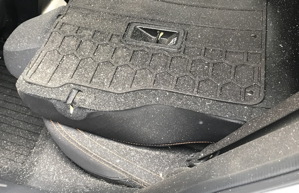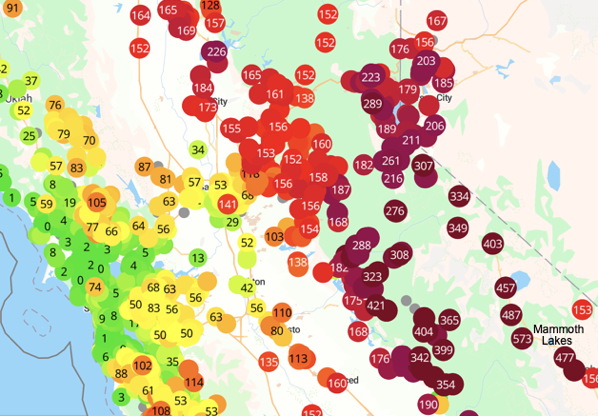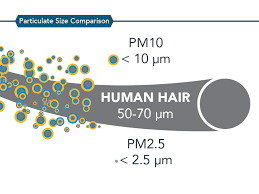 Health
Health  National General Air Quality | California Fires
National General Air Quality | California Fires
 Air Quality Index (AQI) for Smoke
Air Quality Index (AQI) for Smoke
Don's Home
 Health
Health  National General Air Quality | California Fires
National General Air Quality | California Fires
 Air Quality Index (AQI) for Smoke Air Quality Index (AQI) for Smoke
|

| Air Quality Index Levels of Health Concern | Numerical Value |
Breakpoints µg/m3 * |
||
|---|---|---|---|---|
| Good | 0 to 50 | 0 -12.0 | Air quality is satisfactory, and air pollution poses little or no risk. | None |
| Moderate | 51 to 100 | 12.1-35.4 | Air quality is acceptable; However, there may be a risk for some people, particularly those who are unusually sensitive to air pollution. | Unusually sensitive individuals should consider limiting prolonged outdoor exertion |
| Unhealthy for Sensitive Groups | 101 to 150 | 35.5-55.4 | Members of sensitive groups may experience health effects. The general public is less likely to be affected. | Children, active adults, and people with respiratory disease, such as asthma, should limit prolonged outdoor exertion |
| Unhealthy | 151 to 200 | 55.5-150.4 | Some members of the general public may experience health effects; Members of sensitive groups may experience more serious health effects. | Children, active adults, and people with respiratory disease, such as asthma, should avoid prolonged outdoor exertion.; everyone else should limit prolonged outdoor exertion |
| Very Unhealthy | 201 to 300 | 150.5-250.4 | Health alert: The risk of health effects is increased for everyone. | Children, active adults, and people with respiratory disease, such as asthma, should avoid outdoor exertion.; everyone else should limit outdoor exertion |
| Hazardous | 301 to 400 | 250.5-350.4 | Health warning of emergency conditions: Everyone is more likely to be affected. | Everyone should avoid all physical activity outdoors |
| 401-500 | 350.5-500 | |||
Note: Values above 500 are considered Beyond the AQI. Follow recommendations for the "Hazardous category." |
||||
AQI reporting vales vary by the sensor used.
See AQI Measurement
Air Quality Index (AQI) Basics
AQI today and tomorrow for your location | EPA AirNow.gov
AirNow - How is the NowCast algorithm used to report current air quality?
Air Quality Index - A Guide to Air Quality and Your Health
Data Sources - Reports:
California Air Quality Index (AQI) | IqAir
N. Central California | PurpleAir.com | Davis | Homewood
It gives a 6 day forecast and ozone in addition to PM2.5
With Forecast:
AirNow.gov is a partnership of the EPA, NOAA and several other agencies to provide AQI information
Accuweather
Sensors: Accuweather Plume Labs AirNow (EPA) The AirNow site displays hourly, not real-time, readings. Fire and Smoke Map EPA Purple Air The data comes from the commercial sensors the company sells, which members of the public install on porches, yards and other neighborhood sites. Sensors are less accurate than AirNow You can click on "standard" in the box at the bottom to get a conversion to match other AQI systems.Discrepencies in reports:
E.g. on August 23 2021 AQI at Tahoe City was reported as: Purple Air - 770-957 AirNow (EPA)- 566 AccuWeather - 138Anything over 300 is considered hazardous by the EPA and their scale doesn't go above 500

 I left my car windows open a crack because of the 108° temperature and it was covered with ash from the fires in the morning.
I left my car windows open a crack because of the 108° temperature and it was covered with ash from the fires in the morning.
The next day the smoke was blown east to the Sierra Nevada and air quality hit 573 at Mammoth Lakes North-East of the Creek fire.
A day later the air quality averaged 740 over a 2 hour period near Shaver Lake at the edge of the Creek Fire.

Terms:
AQ&U
AQI
CF_ATM
CF_1
LRAPA
PM - Airborne particulate matter (PM) is not a single pollutant, but rather is a mixture of many chemical species. It is a complex mixture of solids and aerosols composed of small droplets of liquid, dry solid fragments, and solid cores with liquid coatings. Particles vary widely in size, shape and chemical composition, and may contain inorganic ions, metallic compounds, elemental carbon, organic compounds, and compounds from the earth’s crust.
Particles are defined by their diameter for air quality regulatory purposes. Those with a diameter of 10 microns or less (PM10) are inhalable into the lungs and can induce adverse health effects. Fine particulate matter is defined as particles that are 2.5 microns or less in diameter (PM2.5).
World Health Organization considers PM2.5 the world’s single biggest environmental health risk.
Particulate matter(PM) is the primary pollutant in the US. PM comes in many different sizes and it can as small as a hair. 90% of the time particulate matter is inviable to human eyes. PM has many sources, such as combustion such burning fuels from cars, ships, airplanes, trucks, buses. Also, it comes from certain types of facilities as cooking facilities, meat industries, wood-burning, wildfires. PM also comes from natural resources like dust and storms. But most of the PM in the is formed by a mix of several pollutants retained in the air.
Indoor PM2.5 levels can be influenced by outdoor sources like vehicle exhaust, wildfires, and power plant emissions.
 See:
See:
Inhalable Particulate Matter and Health (PM2.5 and PM10) | California Air Resources Board
Measuring Instruments for Indoor Environmental Quality
PM2.5 - 2.5 micron or less particle
PM10 - 10 micron or less particle
µg/m3 24- hour fine particle standard in micrograms per cubic meter.